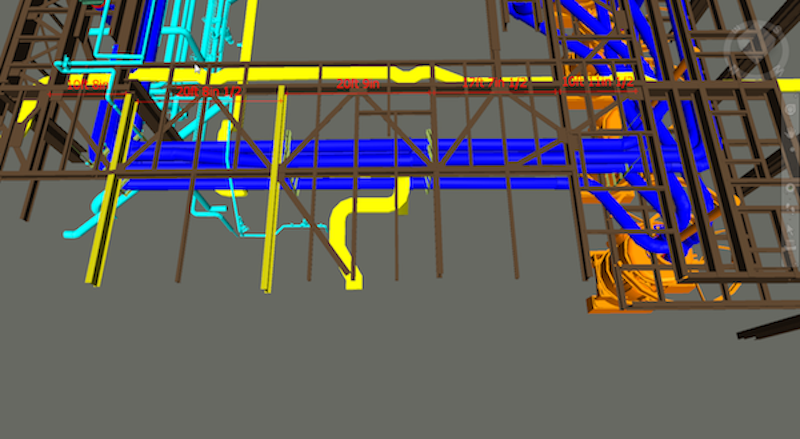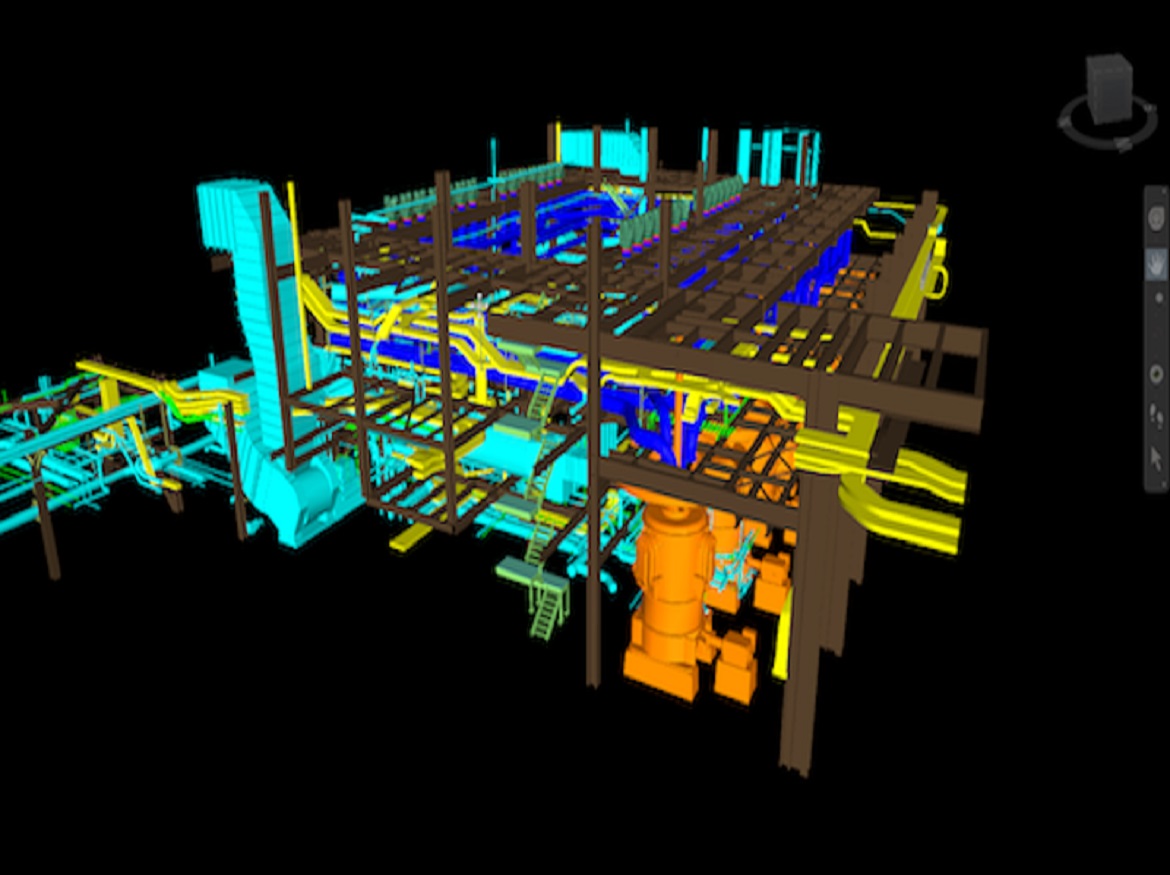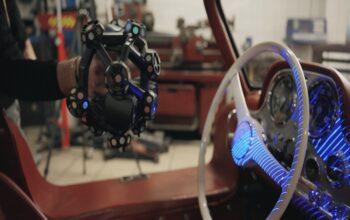Acensium is a provider of engineering consulting services with an emphasis on as-built reality capture and retrofit projects for material handling.
Georgia Power Company’s coal-fired Plant Bowen in Euharlee, Georgia, required a challenging deconstruction and replacement of its Unit-4 fuel line. The fuel line from the pulverizer is blown through with coal dust that has the consistency of talcum powder for igniting. Georgia Power called on Acensium to provide engineering support and handle the piping digitization to assist the demolition and installation/construction teams in order to take on the difficult and inherently dangerous project (Contractor: Zachary; Fabrication: JMS). The fact that the fuel line was constrained by structural parts, floor members, plant equipment, and the boiler itself with minimal clearance to execute the operation was one of the project’s biggest problems. How to get the old pipe out of the building and install the new pipe was a pressing concern.
Originally established in Denver, Colorado, in 2003, Acensium is an engineering consulting services company that specialises in material handling retrofit projects and 3D scanning for as-built reality capture. By drawing on its experience providing engineering and intellectual services, operations, consulting, and engineering support largely for the power, steel, and paper sectors throughout the United States, the team was able to appraise the challenging project and formulate a plan of action.
Challenges
The destruction and replacement of the #4 fuel line was a multi-million dollar job that required 141 workers, a 7-day workweek, and 35 days of plant “outage time” to complete. The scaffolding alone costs millions of dollars. One year was allotted for completion, according to the plans.
The fact that this job required working next to a boiler with an ambient temperature of 120 degrees F made it extremely difficult. Everything fits snugly together because the facility was designed with the equipment in mind.
- Our first job for Bowen had an area of concern 20ft X 20ft x 20ft.
- This Bowen fuel pipe project encompasses a huge volume (sqft) (and a huge amount of data) 80ft x 300ft x 300ft.
In addition to the enormous number of scans, this was a high-heat/high-hazard setting with loud noises and a lot of vibration. It was not a typical industrial workplace, therefore the complicated project required specialist safety training, insurance regulations, and background checks. Scans had to be taken only a few feet from a boiler whose interior temperature was above 1500 degrees F.
Solutions
Plant management asked Acensium to be involved during the planning stage as a consequence of recent accomplishments on multi-million dollar projects and digital visualization for Georgia Power. Acensium used sample scans to show project leads what could be done and what might be accomplished. Georgia Power realized that 3D scanning project control was necessary for the project’s success, so Acensium used FARO® Focus Laser Scanners and SCENE Software.
Instead of using more conventional techniques, the approach involved laborious and time-consuming measurements, estimations, and guesses to ascertain what modifications had been done since the original design decades ago. The use of 3D scanning provides insight to the entire project team because a typical project team cannot understand the full extent of what is happening by simply looking at 2D as-built drawings. Clearances are kept to a minimum when a building is designed around the equipment. For the project to be successful, it was essential to comprehend how each pipe and support worked and how they were arranged.
Everything needed to be planned for success because the complex was practically constructed around the power plant equipment that was installed in 1975. As in a building erected before equipment is installed, there were no clearances built in for the removal or installation of components. To ensure that parts can exit (and enter) the facility as needed, every support beam, pipe, bracket, and bolt had to be taken into account. In place of the initial 50-foot solid length, a pipe may need to be replaced in 10-foot segments, for instance. Without being divided up, it might not even be possible to get 50 feet of pipe inside the building. A highly trained crew and FARO 3D scanning technology were essential for achieving that.
The Ascension Principal, Jason Adkins, asserts that “the personnel’s talents and expertise are crucial. In addition to having top-notch equipment, you also need an engineering mind. It takes a high-level industry professional to efficiently provide engineering consulting and support on assignments like these. By using 3D scanning, modeling, and visualization, you can then convey your expertise to all project stakeholders.

The Modeling Aspect
Parts moving into and out of the confined project area were depicted dynamically. Conflict identification and project process planning were combined in the modeling. Moreover, visualization was employed to improve inter-project stakeholder communication.
It should be mentioned that Acensium was contacted after the procedure had already begun. Acensium typically participates in planning from the very beginning. Only 48 hours prior to the start of the scaffolding buildout, scans were initiated. Before the scaffolding obstructed important viewing angles, the scanning had to be finished. The initial as-built scanning was completed by the Acensium team after 24 hours of nonstop work. The crew was able to prepare for unforeseen problems by using modeling and visualization tools throughout the demolition and installation phases. If more scans of a particular area are required to remedy a problem, they can be done.
Workflow Details
The hardware and settings for FARO Focus dealt with frequent high vibrations. In a high-heat situation with human exposure time, caution was required. Key scans were produced by FARO equipment working for hours in a 120-degree Fahrenheit environment.
Results
Final Deliverables
Model point-cloud overlay, engineering assistance, and project management from conception to completion were among the final deliverables.
Time and Costs Savings
Although it is difficult to estimate exactly how much time was saved, it can be said with confidence that numerous unanticipated problems would have arisen if modeling had not been done. One joint, for instance, requires 22 man-hours to weld. A pipe needs to be rigged for 12 man hours to be picked up. It needs to be disconnected and another pipe rigged if done wrong. In terms of risk avoidance, easily 1500+ man-hours were saved. 20% cost overruns would not be unheard of without visualization.
Conclusion
Since 2009, Acensium has been involved in a large number of projects with Georgia Power, including six previous initiatives at the Bowen facility that used laser scanning to handle coal. Recurring business through Bowen is anticipated to continue, and new projects are already being developed as evidence of the client’s satisfaction with the work that has been accomplished.
Credits: FARO
Click on the following link Metrologically Speaking to read more such case studies about the Metrology Industry.









